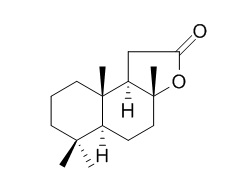Sclareolide
Sclareolide demonstrates a good antibacterial activity against Staphylococcus aureus ATCC 25923, Pseudomonas aeruginosa ATCC 27950, Escherichia coli ATCC 25922 and Enterococcus faecalis ATCC 29212. Sclareolide enhances gemcitabine‑induced cell death through mediating the NICD and Gli1 pathways in gemcitabine‑resistant human pancreatic cancer.
Inquire / Order:
manager@chemfaces.com
Technical Inquiries:
service@chemfaces.com
Tel:
+86-27-84237783
Fax:
+86-27-84254680
Address:
1 Building, No. 83, CheCheng Rd., Wuhan Economic and Technological Development Zone, Wuhan, Hubei 430056, PRC
Providing storage is as stated on the product vial and the vial is kept tightly sealed, the product can be stored for up to
24 months(2-8C).
Wherever possible, you should prepare and use solutions on the same day. However, if you need to make up stock solutions in advance, we recommend that you store the solution as aliquots in tightly sealed vials at -20C. Generally, these will be useable for up to two weeks. Before use, and prior to opening the vial we recommend that you allow your product to equilibrate to room temperature for at least 1 hour.
Need more advice on solubility, usage and handling? Please email to: service@chemfaces.com
The packaging of the product may have turned upside down during transportation, resulting in the natural compounds adhering to the neck or cap of the vial. take the vial out of its packaging and gently shake to let the compounds fall to the bottom of the vial. for liquid products, centrifuge at 200-500 RPM to gather the liquid at the bottom of the vial. try to avoid loss or contamination during handling.
Pharmaceuticals (Basel).2024 Feb 24;17(3):292.
Vietnam Journal of Food Control.2022, 5(3):pp.488-497.
Agriculture2024, 14(12), 2301
Industrial Crops and Products2020, 146:112186
Fitoterapia.2021, 153:104995.
Inflammation.2024, 02034-1.
Phytomedicine.2023, 117:154929.
Biomed Pharmacother.2020, 131:110673.
Chem Biol Interact.2024, 398:111103.
Molecules.2023, 28(4):1785.
Related and Featured Products
Pak J Pharm Sci. 2007 Apr;20(2):146-8.
Antibacterial and cytotoxic activity of the acetone extract of the flowers of Salvia sclarea and some natural products.[Pubmed:
17416571]
The aim of this study was to investigate the antibacterial and the cytotoxic activity of the acetone extract of the flowers of Salvia sclarea and of some natural products (sclareol, Sclareolide and ambrox).
METHODS AND RESULTS:
The antibacterial and the cytotoxic activity were determined by the dilution method. Sclareolide, ambrox and sclareol demonstrated a good antibacterial activity against Staphylococcus aureus ATCC 25923, Pseudomonas aeruginosa ATCC 27950, Escherichia coli ATCC 25922 and Enterococcus faecalis ATCC 29212. The acetonic extract of the flowers of Salvia sclarea has a significant cytotoxic activity against Hep-2 cells.
Mol Med Rep. 2017 Apr;15(4):1461-1470.
Sclareolide enhances gemcitabine‑induced cell death through mediating the NICD and Gli1 pathways in gemcitabine‑resistant human pancreatic cancer.[Pubmed:
28259943 ]
Pancreatic cancer is a type of cancer, which rapidly develops resistance to chemotherapy. Gemcitabine is the treatment used clinically, however, gemcitabine resistance leads to limited efficacy and patient survival rates of only a few months following diagnosis.
METHODS AND RESULTS:
The aim of the present study was to investigate the mechanisms underlying gemcitabine resistance in pancreatic cancer and to select targeted agents combined with gemcitabine to promote the treatment of pancreatic cancer. Panc‑1 and ASPC‑1 human pancreatic cancer cells (HPCCs) were used to establish the experimental model, and HPCCs were exposed to gemcitabine of serially increased concentrations to generate gemcitabine‑resistant cells (GR‑HPCCs). The anticancer effect of gemcitabine combined with Sclareolide was then assessed. Epithelial to mesenchymal transition (EMT), human equilibrative nucleoside transporter 1 (hENT1) and ribonucleoside diphosphate reductase 1 (RRM1) were detected in the HPCCs and GR‑HPCCs, and the mechanisms were investigated. Sclareolide resensitized the GR‑HPCCs to gemcitabine. The expression levels of hENT1 and RRM1 were lower and higher, respectively, in GR‑HPCCs, compared with HPCCs. Sclareolide upregulated hENT1, downregulated RRM1 and inhibited gemcitabine‑induced EMT through the TWIST1/Slug pathway in the GR‑HPCCs. In addition, Sclareolide mediated the NOTCH 1 intracellular cytoplasmic domain (NICD)/glioma‑associated oncogene 1 (Gli1) pathway, which triggered TWIST1/Slug‑hENT1/RRM1 signaling and resensitized GR‑HPCCs to gemcitabine. Finally, Sclareolide resensitized GR‑HPCCs to gemcitabine through inducing apoptosis; in vivo, the co‑administraion of Sclareolide and gemcitabine effectively suppressed tumor growth.
CONCLUSIONS:
Sclareolide may be a novel agent in combination with gemcitabine for the treatment of gemcitabine‑resistant pancreatic cancer, which resensitizes GR‑HPCCs to gemcitabine through mediating NICD and Gli1.



